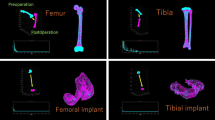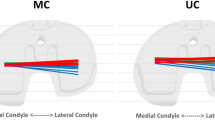Abstract
Purpose
Unicompartmental knee arthroplasty (UKA), resulting in similar kinematics to native knees, is functionally superior to total knee arthroplasty (TKA). However, ACL deficiency is generally considered to be a contraindication. The main purpose of this study was to investigate if UKA in ACL-deficient knees would result in similar kinematics to conventional UKA with an intact ACL.
Methods
Ten conventional UKA patients were compared to eight ACL-deficient patients with a reduced tibial slope to compensate for instability, resulting from the deficient ACL. Knee kinematics was evaluated with a moving fluoroscope, tracking the knee joint during daily activities. In a standing position (baseline), posterior shift of the femur was observed for ACL-deficient UKA patients, compared to conventional UKA patients.
Results
A significant posterior femoral shift in the ACL-deficient group was observed during the first 25% (near extension) of deep knee bend, while there was no difference in kinematic waveforms for all other activities. No significant range of motion differences across different activities between the two UKA groups were detected, except for an increase of medial AP translation in the ACL-deficient group, during deep knee bend and stair descent.
Conclusion
Despite the posterior femoral shift due to ACL deficiency, both UKA groups showed similar kinematic waveforms, indicating that posterior tibial slope reduction can partially compensate for ACL function. This supported our hypothesis that fixed bearing UKA can be a viable treatment option for selected ACL-deficient patients, allowing patient-specific kinematics. While anteroposterior laxity can be compensated, rotational stability was a prerequisite for this approach.
Level of evidence
III.





Similar content being viewed by others
Abbreviations
- UKAI:
-
UKA patients with intact ACL
- UKAD:
-
UKA patients with deficient ACL
- Trans:
-
Translation
References
Banks SA, Fregly BJ, Boniforti F, Reinschmidt C, Romagnoli S (2005) Comparing in vivo kinematics of unicondylar and bi-unicondylar knee replacements. Knee Surg Sports Traumatol Arthrosc 13:551–556
Blunn GW, Walker PS, Joshi A, Hardinge K (1991) The dominance of cyclic sliding in producing wear in total knee replacements. Clin Orthop Relat Res 273:253–260
Boissonneault A, Pandit H, Pegg E, Jenkins C, Gill HS, Dodd CAF, Gibbons CLMH, Murray DW (2013) No difference in survivorship after unicompartmental knee arthroplasty with or without an intact anterior cruciate ligament. Knee Surg Sports Traumatol Arthrosc 21:2480–2486
Brown NM, Sheth NP, Davis K, Berend ME, Lombardi AV, Berend KR, Della Valle CJ (2012) Total knee arthroplasty has higher postoperative morbidity than unicompartmental knee arthroplasty: a multicenter analysis. J Arthroplasty 27:86–90
Burckhardt K, Székely G, Nötzli H, Hodler J, Gerber C (2005) Submillimeter measurement of cup migration in clinical standard radiographs. IEEE Trans Med Imaging 24:676–688
Dalury DF, Fisher DA, Adams MJ, Gonzales RA (2009) Unicompartmental knee arthroplasty compares favorably to total knee arthroplasty in the same patient. Orthopedics 32:253–257
Engh GA, Ammeen D (2004) Is an intact anterior cruciate ligament needed in order to have a well-functioning unicondylar knee replacement? Clin Orthop Relat Res 428:170–173
Forster-Horváth C, Artz N, Hassaballa MA, Robinson JR, Porteous AJ, Murray JR, Newman JH (2016) Survivorship and clinical outcome of the minimally invasive uniglide medial fixed bearing, all-polyethylene tibia, unicompartmental knee arthroplasty at a mean follow-up of 7.3 years. Knee 23:981–986
Freeman MAR, Pinskerova V (2005) The movement of the normal tibio-femoral joint. J Biomech 38:197–208
Friston KJ, Holmes AP, Worsley KJ, Poline JP, Frith CD, Frackowiak RS (1995) Statistical parametric maps in functional imaging: a general linear approach. Hum Brain Mapp 2:189–210
Goodfellow JW, Kershaw CJ, Benson MK, O’Connor JJ (1988) The Oxford Knee for unicompartmental osteoarthritis. The first 103 cases. J Bone Joint Surg Br 70:692–701
Grood ES, Suntay WJ (1983) A joint coordinate system for the clinical description of three-dimensional motions: application to the knee. J Biomech Eng 105:136–144
Hernigou P, Deschamps G (2004) Posterior slope of the tibial implant and the outcome of unicompartmental knee arthroplasty. J Bone Joint Surg Am 86-A:506–511
Johal P, Williams A, Wragg P, Hunt D, Gedroyc W (2005) Tibio-femoral movement in the living knee. A study of weight bearing and non-weight bearing knee kinematics using ‘interventional’ MRI. J Biomech 38:269–276
Johnson AJ, Howell SM, Costa CR, Mont MA (2013) The ACL in the arthritic knee: how often is it present and can preoperative tests predict its presence? Clin Orthop Relat Res 471:181–188
Jones LD, Palmer J, Jackson WF (2017) Unicompartmental knee arthroplasty. Orthopaed Trauma 31:8–15
Lee G, Cushner FD, Vigoritta V, Scuderi GR, Insall JN, Scott WN (2005) Evaluation of the anterior cruciate ligament integrity and degenerative arthritic patterns in patients undergoing total knee arthroplasty. J Arthroplasty 20:59–65
List R, Postolka B, Schütz P, Hitz M, Schwilch P, Gerber H, Ferguson SJ, Taylor WR (2017) A moving fluoroscope to capture tibiofemoral kinematics during complete cycles of free level and downhill walking as well as stair descent. PLoS ONE 12:1–13
Moro-oka T, Muenchinger M, Canciani J, Banks SA (2007) Comparing in vivo kinematics of anterior cruciate-retaining and posterior cruciate-retaining total knee arthroplasty. Knee Surg Sports Traumatol Arthrosc 15:93–99
Pataky TC (2010) Generalized n-dimensional biomechanical field analysis using statistical parametric mapping. J Biomech 43:1976–1982
Patil S, Colwell CW, Ezzet KA, D’Lima DD (2005) Can normal knee kinematics be restored with unicompartmental knee replacement? J Bone Joint Surg Am 87:332–338
Rong GW, Wang YC (1987) The role of cruciate ligaments in maintaining knee joint stability. Clin Orthop Relat Res 215:65–71
Schütz P, Postolka B, Gerber H, Ferguson SJ, Taylor WR, List R (2019) Knee implant kinematics are task-dependent. J R Soc Interface 16:1–11
Suero EM, Citak M, Cross MB, Bosscher MRF, Ranawat AS, Pearle AD (2012) Effects of tibial slope changes in the stability of fixed bearing medial unicompartmental arthroplasty in anterior cruciate ligament deficient knees. Knee 19:365–369
Suggs JF, Li G, Park SE, Sultan PG, Rubash HE, Freiberg AA (2006) Knee biomechanics after UKA and its relation to the ACL—a robotic investigation. J Orthop Res 24:588–594
Taylor WR, Schütz P, Bergmann G, List R, Postolka B, Hitz M, Dymke J, Damm P, Duda G, Gerber H, Schwachmeyer V, Hosseini Nasab SH, Trepczynski A, Kutzner I (2017) A comprehensive assessment of the musculoskeletal system: the CAMS-Knee data set. J Biomech 65:32–39
Varadarajan KM, Zumbrunn T, Rubash HE, Malchau H, Muratoglu OK, Li G (2015) Reverse engineering nature to design biomimetic total knee implants. J Knee Surg 28:363–369
Willis-Owen CA, Brust K, Alsop H, Miraldo M, Cobb JP (2009) Unicondylar knee arthroplasty in the UK National Health Service: an analysis of candidacy, outcome and cost efficacy. Knee 16:473–478
Yue B, Varadarajan KM, Moynihan AL, Liu F, Rubash HE, Li G (2011) Kinematics of medial osteoarthritic knees before and after posterior cruciate ligament retaining total knee arthroplasty. J Orthop Res 29:40–46
Zihlmann MS, Gerber H, Stacoff A, Burckhardt K, Székely G, Stüssi E (2006) Three-dimensional kinematics and kinetics of total knee arthroplasty during level walking using single plane video-fluoroscopy and force plates: a pilot study. Gait Posture 24:475–481
Acknowledgements
The authors of this manuscript would like to thank all members of the Institute for Biomechanics for their help during the experiments or establishing the required hardware and software processes. Specifically, we would like to thank Lorena Suter and Adrian Roth for the 2D/3D registration, Luca Kiener for the validation experiments, Donato Papillo for his help with patient recruitment, and all patients for participating in this study.
Funding
This study was funded by the Mäxi Foundation, departmental grants of ETH Zurich and Schulthess Klinik, together with industry support from DePuy Synthes.
Author information
Authors and Affiliations
Contributions
TZ participated in study conception, data acquisition, data analysis, and interpretation, and wrote the initial draft of the manuscript. PS participated in design of methods, data acquisition and data analysis. FvK participated in study conception, patient recruitment and provided clinical input for data interpretation. SP participated in study conception and patient recruitment, and provided clinical input for data interpretation. RL participated in design of methods and data analysis, and provided biomechanical input for data interpretation. SF participated in study conception, design of methods, data analysis, and provided biomechanical input for data interpretation. All authors read and approved the final manuscript.
Corresponding author
Ethics declarations
Conflict of interest
This study was partially supported by the implant manufacturer and institutional research funding was received from several medical device companies. Some of the authors are paid consultants for medical device companies not related to this study. One author was a paid employee at a medical device company not involved in this project.
Ethical approval
All procedures performed in studies involving human participants were in accordance with the ethical standards of the institutional review board at ETH Zurich and the Zurich cantonal ethics committee (BASEC-No. 2016-00438) and with the 1964 Helsinki declaration and its later amendments or comparable ethical standards.
Additional information
Publisher's Note
Springer Nature remains neutral with regard to jurisdictional claims in published maps and institutional affiliations.
This research was carried out at the Institute for Biomechanics at ETH Zurich.
Rights and permissions
About this article
Cite this article
Zumbrunn, T., Schütz, P., von Knoch, F. et al. Medial unicompartmental knee arthroplasty in ACL-deficient knees is a viable treatment option: in vivo kinematic evaluation using a moving fluoroscope. Knee Surg Sports Traumatol Arthrosc 28, 1765–1773 (2020). https://doi.org/10.1007/s00167-019-05594-0
Received:
Accepted:
Published:
Issue Date:
DOI: https://doi.org/10.1007/s00167-019-05594-0




